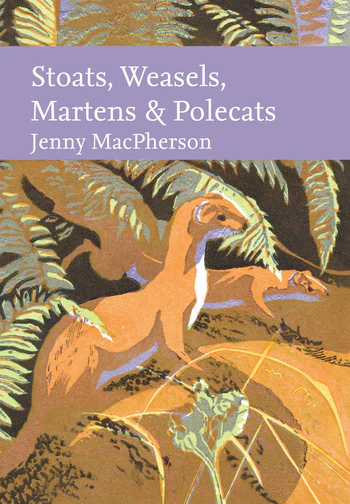
This is a very interesting book about a very few species and a very good New Naturalist. The New Naturalist series put out some rather unattractive books a while ago with terribly reproduced and somewhat irrelevant images. Those days have certainly passed. This is a well-produced volume with good photographs, graphs and figures.
The author works for the Vincent Wildlife Trust and works on these species so she knows her stuff. I wondered whether there was enough to say about long thin carnivorous beasts but there is. The four main species are given some support by information about other mustelids, some away from the UK and the American Mink which ought to be away from the UK.
I haven’t read every word on every page of this book because I can’t imagine that many will. I dipped into it (sometimes when an interesting graph caught my attention) and found that my dipping turned into a good long swim through the adjacent pages. That’s always a sign of a good book – one that keeps you with it by interesting you.
Another thing I do, is to think what subjects I want to read about in any particular book. With this one I wanted to read what the author says about the impact of Pine Martens on Grey and Red Squirrels and whether the oft-mentioned impact of returning Otters on American Mink (the mink decline) is true or not.
The Pine Marten – Grey Squirrel – Red Squirrel tale is well told and very interesting. I thought the author didn’t quite come down as strongly as she should on the real potential for Pine Martens to be the Nemesis of Greys and the saviour of Reds – and if nothing else, where it works it will be a much, much, much cheaper way of reducing a problem (or several problems) than anything else.
Does the return of the Otter drive American Mink numbers down? This seems quite a bit less certain and, again, the author doesn’t quite tell us what she believes. The phrase ‘…local and short-term declines in mink abundance have been observed as otters have recovered in numbers.’ is suggestive but not clear as I, the reader, don’t know whether the studies show a short-term decline because they only lasted a while (so who knows?) or whether this means that the short-term decline was reversed a bit later and likewise for ‘local’, is it that the studies were small scale (so who knows whether there was a wider impact?) or the decline was shown to be limited in extent? And how many studies were there? The best of copy editors would have given the author a nudge here and asked ‘What do you want the reader to think on this question – you’ll have to tell them what you think’. Cautious scientists need to be encouraged to say what they think, honestly and not claiming that they are sure, but if the experts can’t say ‘I reckon the return of the Otter does make a small difference to American Mink numbers but only in some places and only along watercourses. Of course there are loads of mink away from rivers and streams too.’ or something to that effect then who can? If the experts can’t be persuaded to let their hair down slightly in a New Naturalist then where will they?
I might have gone on about that a bit too long, so I’ll come back to telling you what a great book this is. Having had a holiday on the Uists recently, I was fascinated to read of the Hebridean Mink Project – there was a good description of the problem and of potential solutions here and I thought it was very interesting. This type of well-explained example is what the lay reader might well need to realise that things are complicated, that thought, a lot of thought, goes into such work, and you can’t be quite sure what will happen until you get stuck in.
Similarly, the accounts of Pine Marten reintroduction are detailed, give the reader information that they would struggle to find elsewhere and are very interesting as a case study and informative in general on reintroductions.
The book deals very well with persecution in the historical past and more up to date times and the chapter on mythology and monarchy, folklore and ermine, is very entertaining.
I couldn’t help frequently thinking that these creatures are fascinating but that all four of them, perhaps particularly Weasels and Stoats are generally classed as ‘vermin’ by shooting interests. In my book Inglorious I recall the fairly recent statement by the owner of two grouse moors in Weardale that his gamekeepers killed 600 Stoats a year on those two moors. The short passage which spans the bottom of page 257 and the top of page 258 is relevant here and should be read and inwardly digested by all grouse moor managers and their gamekeepers who often fail to grasp it (or do they grasp it but still don’t admit it?). That passage is ‘… while predator removal can fulfil the primary objective of game managers, which is to generate an artificial supply of birds and, thereby, larger shooting bags, it may not be necessary to fulfil the rather different objective of conservation managers, which is to maximise stable breeding numbers.‘.
This is a really good book. I liked it very much. I hope it is widely read and not just bought as part of a collection of New Naturalists. Some New Naturalists are more worth reading than others – this is one to be read, not just owned.
The cover – lovely by Robert Greenhalf, whose New Naturalist covers seem to be getting more and more similar to Robert Gillmor’s, and that is meant only a compliment – I’d give this one 9/10.
Stoats, Weasels, Martens and Polecats by Jenny MacPherson is published by Harper Collins.
.
Buy direct from Blackwell’s – a proper bookshop (and I’ll get a little bit of money from them)

Pine Martens are native to Mull but the author thinks otherwise as she has never seen the historical vermin lists from the estates there only listed to Nature Scot!!